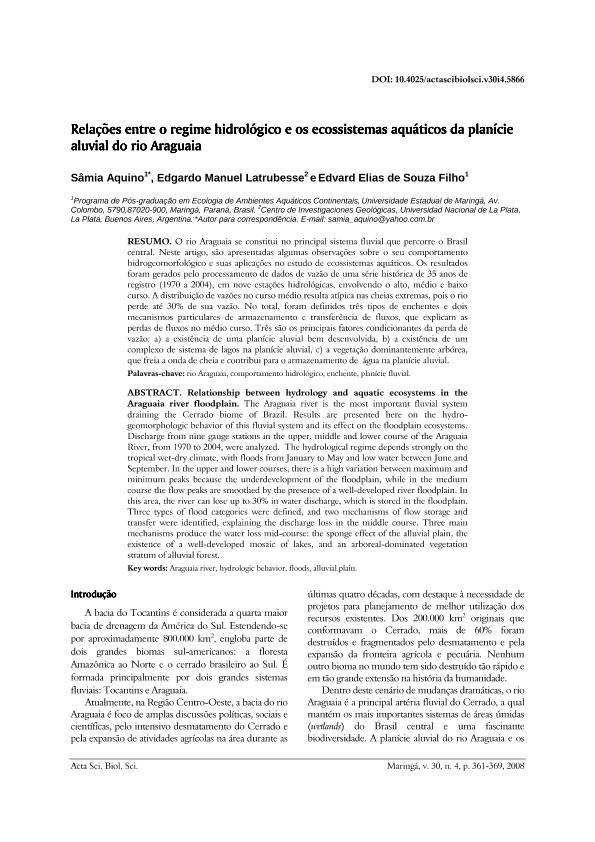Mostrar el registro sencillo del ítem
dc.contributor.author
Aquino, Sâmia
dc.contributor.author
Latrubesse, Edgardo Manuel

dc.contributor.author
de Souza Filho, Edvard Elias
dc.date.available
2019-04-16T19:18:30Z
dc.date.issued
2008-12
dc.identifier.citation
Aquino, Sâmia; Latrubesse, Edgardo Manuel; de Souza Filho, Edvard Elias; Relações entre o regime hidrológico e os ecossistemas aquáticos da planície aluvial do rio Araguaia; Universidade Estadual de Maringá; Acta Scientiarum - Biological Sciences; 30; 4; 12-2008; 361-369
dc.identifier.issn
1679-9283
dc.identifier.uri
http://hdl.handle.net/11336/74509
dc.description.abstract
O rio Araguaia se constitui no principal sistema fluvial que percorre o Brasil central. Neste artigo, são apresentadas algumas observações sobre o seu comportamento hidrogeomorfológico e suas aplicações no estudo de ecossistemas aquáticos. Os resultados foram gerados pelo processamento de dados de vazão de uma série histórica de 35 anos de registro (1970 a 2004), em nove estações hidrológicas, envolvendo o alto, médio e baixo curso. A distribuição de vazões no curso médio resulta atípica nas cheias extremas, pois o rio perde até 30% de sua vazão. No total, foram definidos três tipos de enchentes e dois mecanismos particulares de armazenamento e transferência de fluxos, que explicam as perdas de fluxos no médio curso. Três são os principais fatores condicionantes da perda de vazão: a) a existência de uma planície aluvial bem desenvolvida, b) a existência de um complexo de sistema de lagos na planície aluvial, c) a vegetação dominantemente arbórea, que freia a onda de cheia e contribui para o armazenamento de água na planície aluvial.
dc.description.abstract
The Araguaia river is the most important fluvial system draining the Cerrado biome of Brazil. Results are presented here on the hydrogeomorphologic behavior of this fluvial system and its effect on the floodplain ecosystems. Discharge from nine gauge stations in the upper, middle and lower course of the Araguaia River, from 1970 to 2004, were analyzed. The hydrological regime depends strongly on the tropical wet-dry climate, with floods from January to May and low water between June and September. In the upper and lower courses, there is a high variation between maximum and minimum peaks because the underdevelopment of the floodplain, while in the medium course the flow peaks are smoothed by the presence of a well-developed river floodplain. In this area, the river can lose up to 30% in water discharge, which is stored in the floodplain. Three types of flood categories were defined, and two mechanisms of flow storage and transfer were identified, explaining the discharge loss in the middle course. Three main mechanisms produce the water loss mid-course: the sponge effect of the alluvial plain, the existence of a well-developed mosaic of lakes, and an arboreal-dominated vegetation stratum of alluvial forest.
dc.format
application/pdf
dc.language.iso
por
dc.publisher
Universidade Estadual de Maringá

dc.rights
info:eu-repo/semantics/openAccess
dc.rights.uri
https://creativecommons.org/licenses/by-nc-sa/2.5/ar/
dc.subject
Alluvial Plain
dc.subject
Araguaia River
dc.subject
Floods
dc.subject
Hydrologic Behavior
dc.subject
Rio Araguaia
dc.subject
Comportamento Hidrológico
dc.subject
Enchente
dc.subject
Planície Fluvial
dc.subject.classification
Geología

dc.subject.classification
Ciencias de la Tierra y relacionadas con el Medio Ambiente

dc.subject.classification
CIENCIAS NATURALES Y EXACTAS

dc.title
Relações entre o regime hidrológico e os ecossistemas aquáticos da planície aluvial do rio Araguaia
dc.title
Relationship between hydrology and aquatic ecosystems in the Araguaia river floodplain
dc.type
info:eu-repo/semantics/article
dc.type
info:ar-repo/semantics/artículo
dc.type
info:eu-repo/semantics/publishedVersion
dc.date.updated
2019-03-26T20:34:24Z
dc.identifier.eissn
1807-863X
dc.journal.volume
30
dc.journal.number
4
dc.journal.pagination
361-369
dc.journal.pais
Brasil

dc.journal.ciudad
Maringá
dc.description.fil
Fil: Aquino, Sâmia. Universidade Estadual de Maringá, Paraná; Brasil
dc.description.fil
Fil: Latrubesse, Edgardo Manuel. Consejo Nacional de Investigaciones Científicas y Técnicas. Centro Científico Tecnológico Conicet - La Plata. Centro de Investigaciones Geológicas. Universidad Nacional de La Plata. Facultad de Ciencias Naturales y Museo. Centro de Investigaciones Geológicas; Argentina
dc.description.fil
Fil: de Souza Filho, Edvard Elias. Universidade Estadual de Maringá, Paraná; Brasil
dc.journal.title
Acta Scientiarum - Biological Sciences

dc.relation.alternativeid
info:eu-repo/semantics/altIdentifier/doi/http://dx.doi.org/10.4025/actascibiolsci.v30i4.5866
dc.relation.alternativeid
info:eu-repo/semantics/altIdentifier/url/http://periodicos.uem.br/ojs/index.php/ActaSciBiolSci/article/view/5866
Archivos asociados
